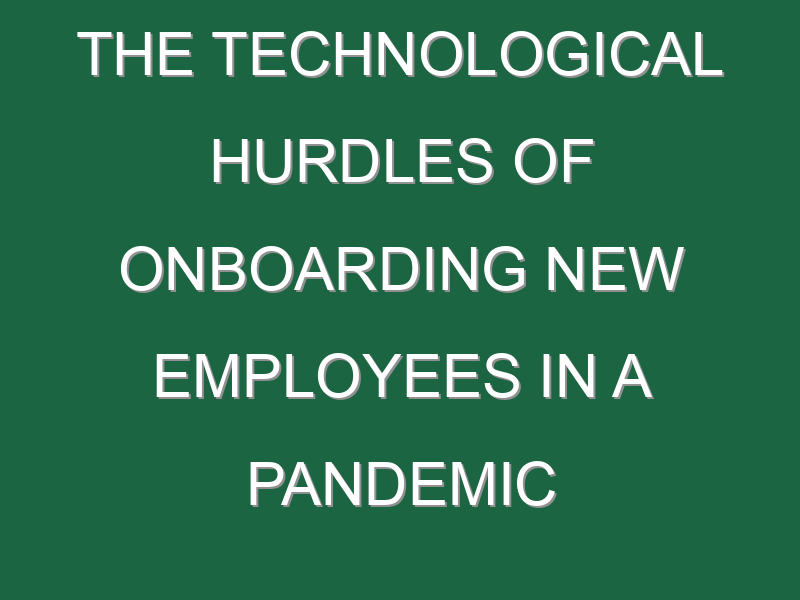It’s challenging enough to find a qualified new employee in the midst of a pandemic, but once you do, making the person feel like a member of the team can be especially hard.
Human contact is still not safe. The days of office holiday parties and after-work drinks at the bar around the corner are long gone. And training without hands-on time is difficult. But just as technology is creating new normals for interoffice communication, human resource departments are finding innovative ways to welcome new employees into the fold.
“The challenge is building those personal relationships, those workplace relationships that develop a connection and rapport with your coworkers,” says Julie Schweber, senior HR knowledge adviser at SHRM (the Society for Human Resource Management). “It’s definitely more difficult.”
Bringing a new worker into a company virtually presents some unique challenges. It can be harder to convey the company’s culture. New hires are more hesitant to say they don’t understand their responsibilities or reticent to ask how to do certain tasks via Zoom versus in person. And there can be productivity gaps, where the worker is unsure what to do next, without a formal plan in place.
There are, however, some ways to make virtual onboarding easier.
First, it’s more important than ever for new workers to have a mentor or guide in their first few weeks. Pairing recent hires with a current employee helps them get familiar with the ins and outs of an organization. It’s important, notes Schweber, that this mentor/guide not be someone who would be a supervisor or overseer. New workers need to be able to ask questions they might be too shy to ask their boss.
That not only helps people get acclimated at the job, it also could keep them there for a longer time.
“We all like that connection at work,” she says. “Relationships with coworkers have proven to be one of the chief retention tools for workers. Some employees don’t want to leave because they like their coworkers so much.”
That’s not to say managers should remain distant, though. Regular, one-on-one teleconference or phone check-ins are critical in making the employee feel like part of the team—and making sure the person isn’t not facing any obstacles.
“It sends the message, ‘We are here to support you and want you to succeed,’” says Schweber.
Zoom, Microsoft Teams, WebEx, and other teleconferencing tools—along with well-known office chat programs like Slack—are the primary devices most companies are using to onboard employees, but some workplaces are taking a more creative approach.
Chobani, for example, has incorporated augmented reality (AR) into its tool set to help with startup training, as well as allowing a group of people to assist with maintenance and repair, with only one physically handling the issue.
Plant employees wear a headset that allows a remote person (or persons) to see what employees on site are looking at and communicate with them. And, as a bonus, it not only reduces the risk of COVID spread, it also reduces costs.
“When someone’s doing training, it’s generally either Group A or Group B traveling to see the other to do the trailing,” says Hugh Roddy, vice president of global engineering and project management at Chobani. “With augmented reality, Group A and Group B can stay in their own location. From a cost perspective, it’s out of this world. It allows us to remotely bring people into a facility and interact with them.”
Other companies, including Walmart and UPS, have long since incorporated virtual reality into their training programs. (Walmart’s programs range from training associates on day-to-day duties to handling crisis events in a store. UPS uses HTC Vive VR headsets to help drivers spot potential hazards when “driving” down a virtual road.)
Long term, these AR onboarding and education tools could have an additional benefit for companies. Since the presentations are done via video, Chobani is recording them and assembling a library that workers can use for refresher courses or to learn new skills.
Right now, that’s largely confined to the engineering/product management departments, but Roddy says he expects the practice to expand companywide in the months to come. “I see every major department in the company building their own libraries of content, whether they’re doing trials or demonstrations.”
More must-read tech coverage from Fortune:
- Technology’s growing role in fixing the mental health crisis
- What is Signal, and is it really safer than WhatsApp?
- Can former Cisco CTO Padmasree Warrior build a better social network for book lovers?
- Coinbase is pegged for a valuation of up to $75 billion. Is that realistic?
- Airbnb’s CEO on how COVID has changed travel forever





